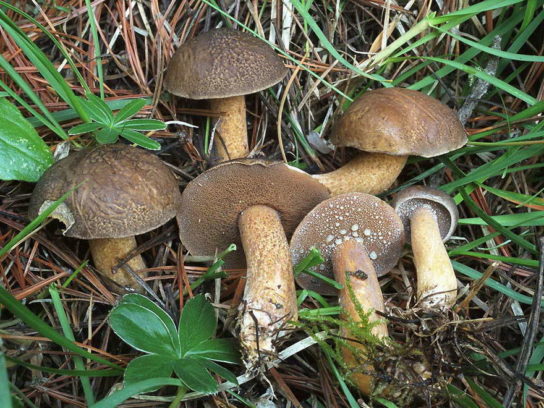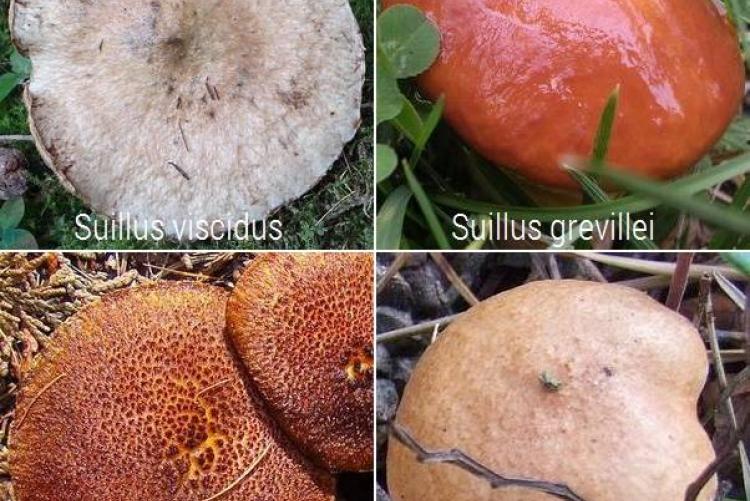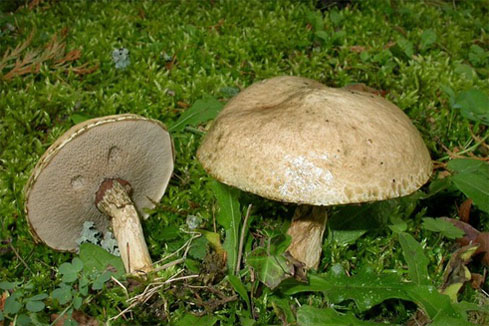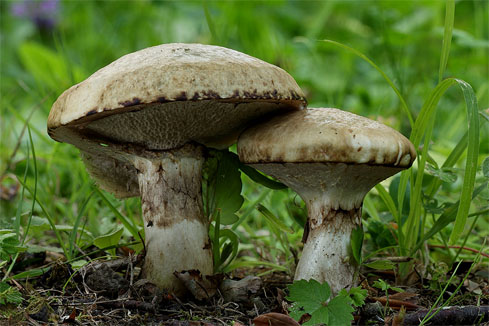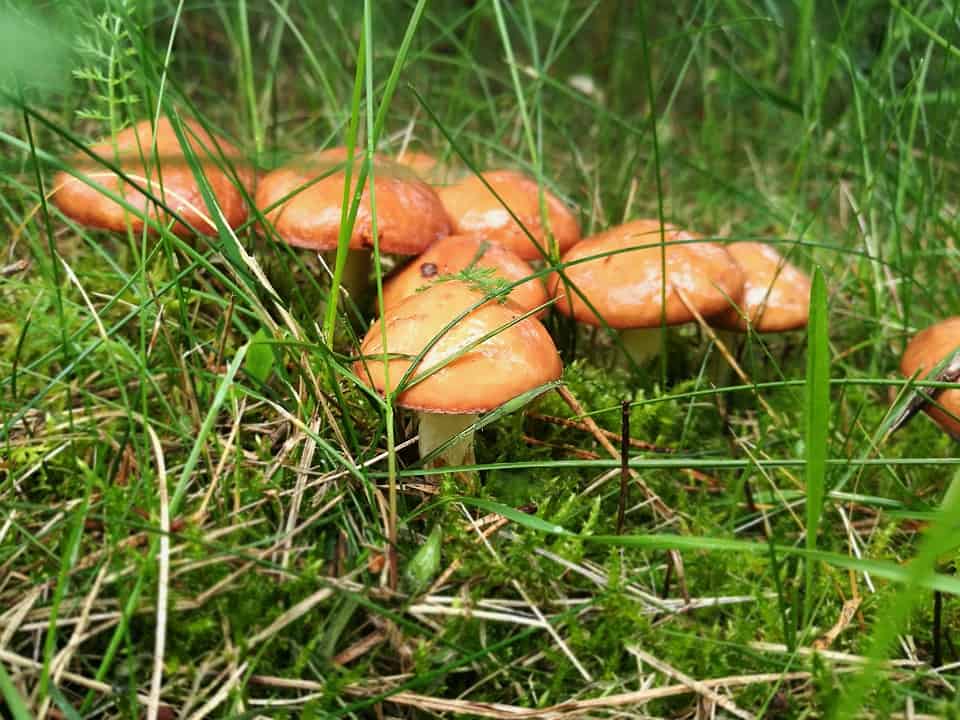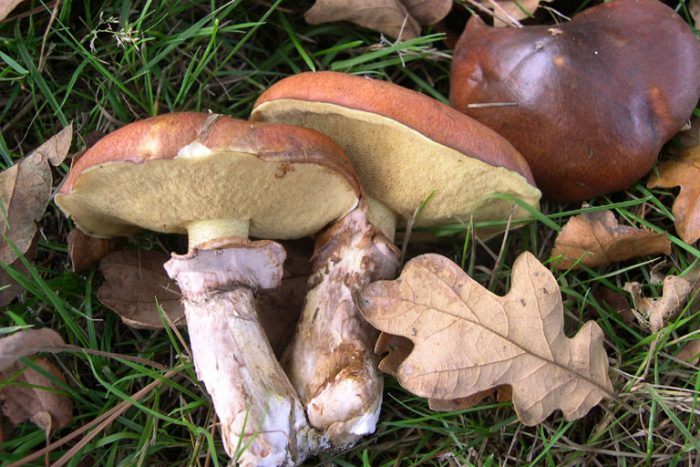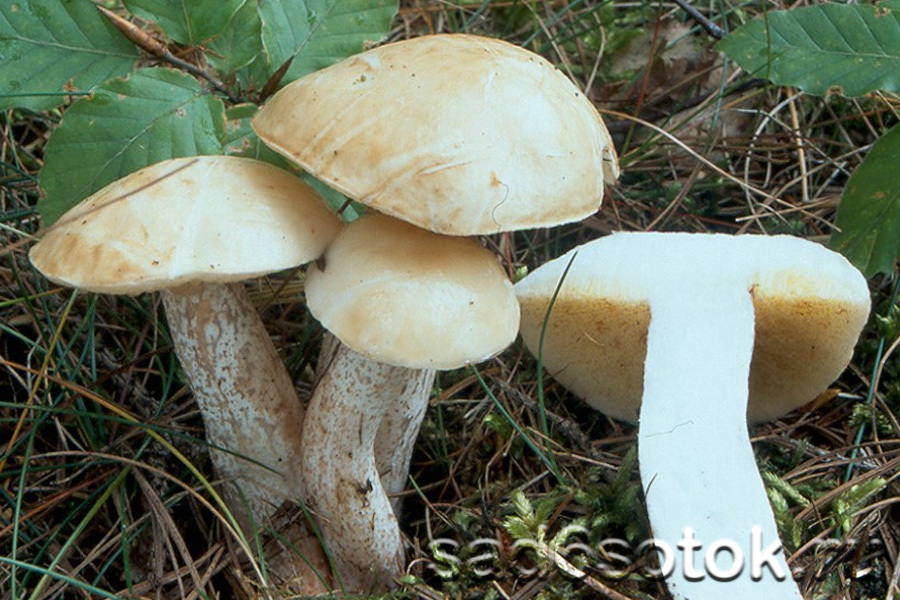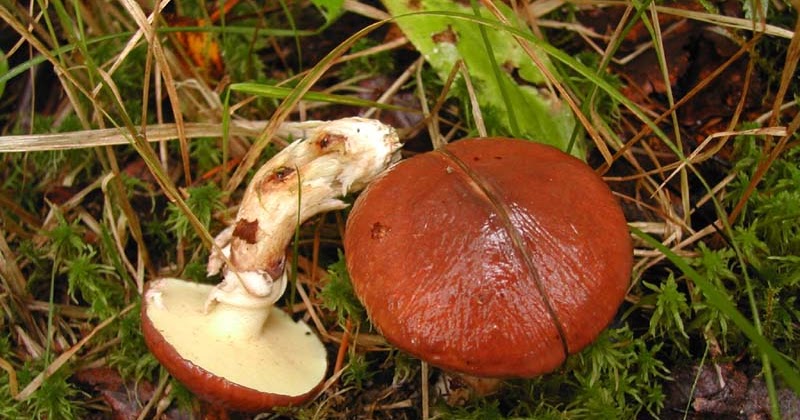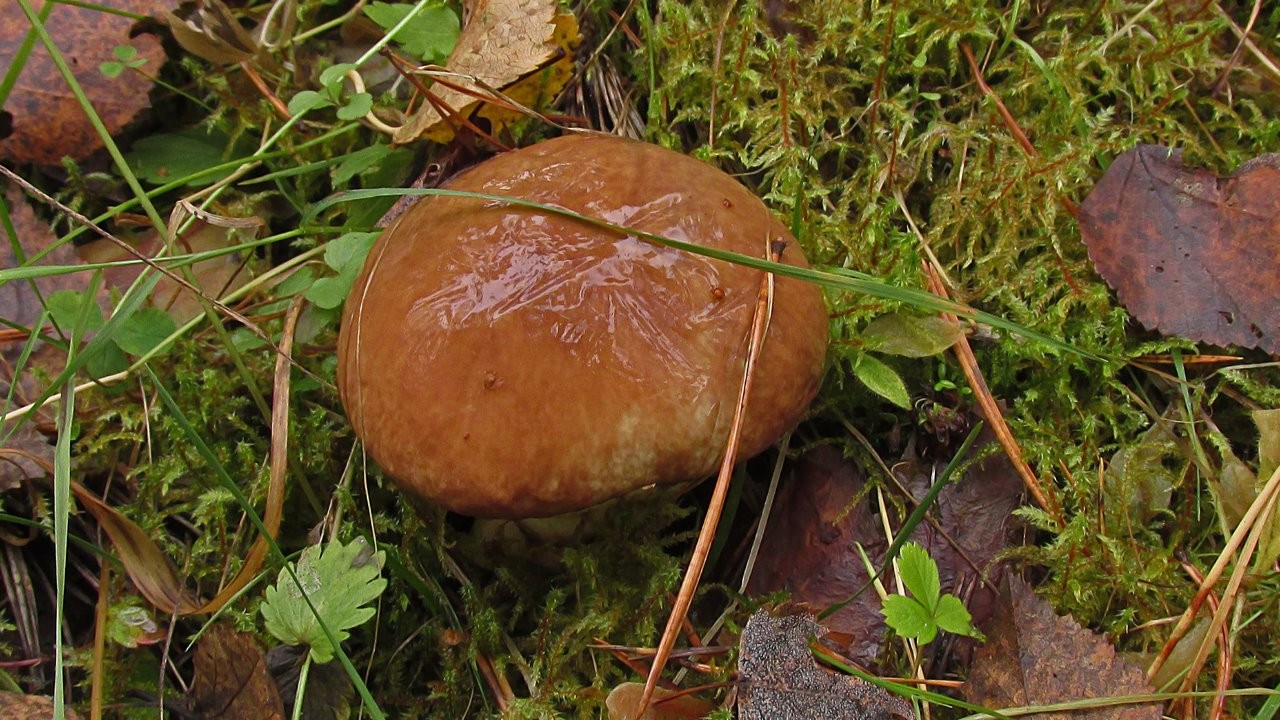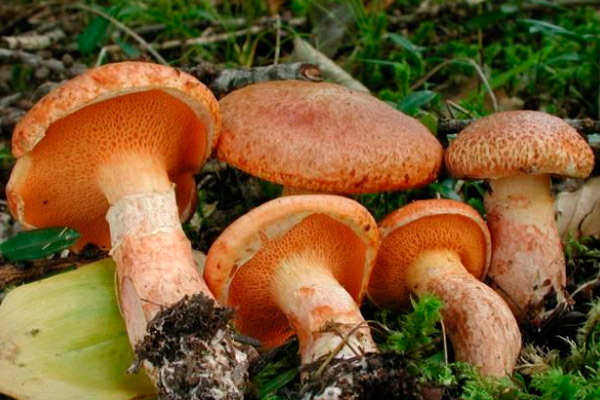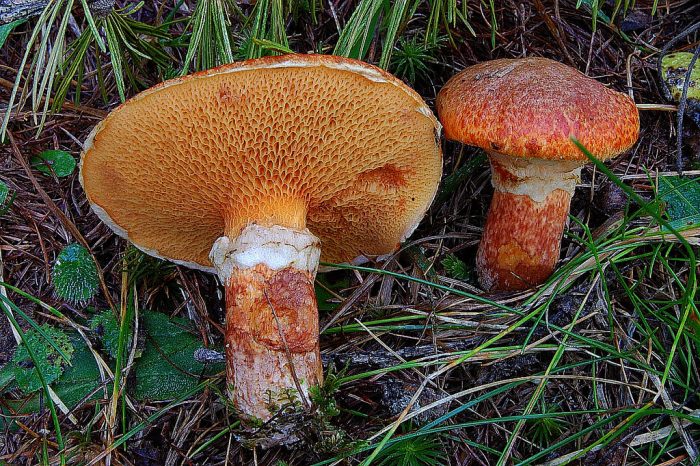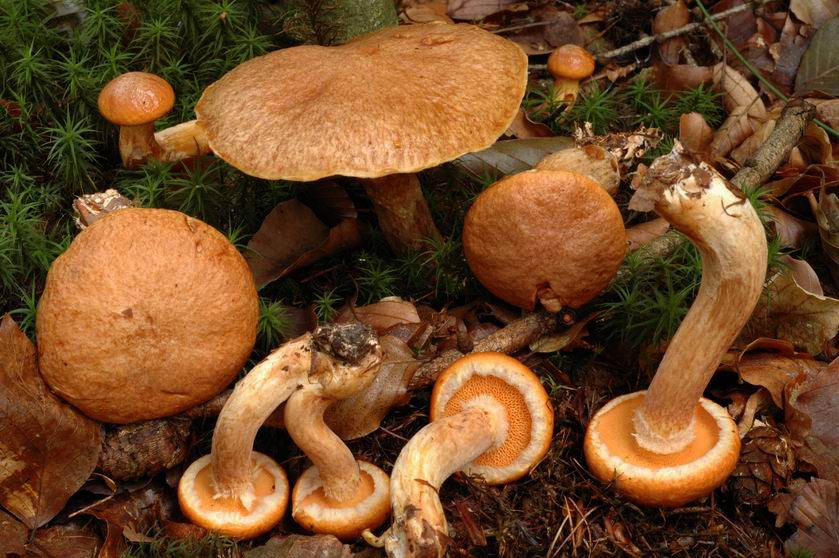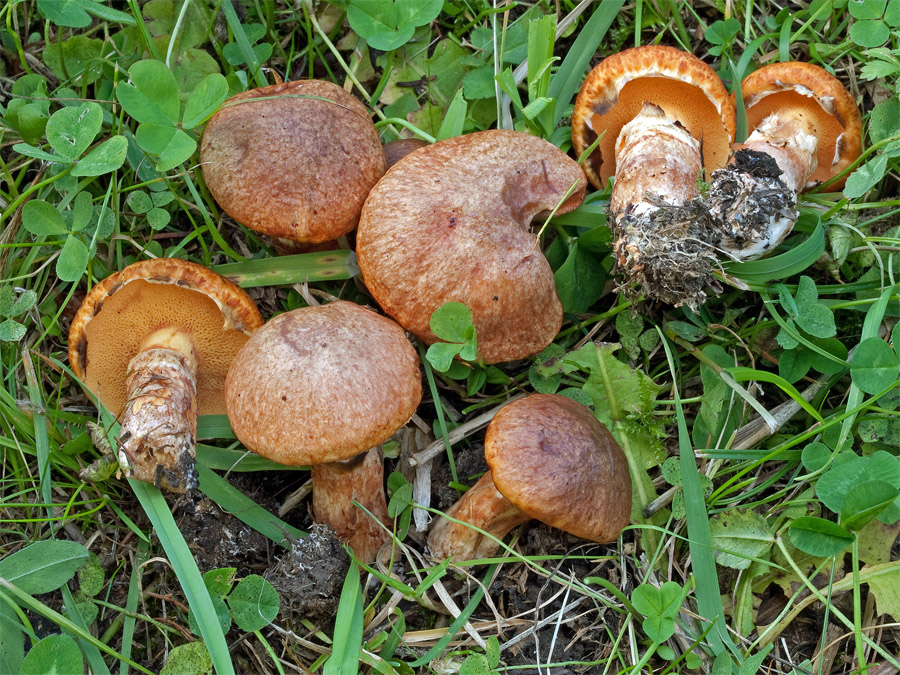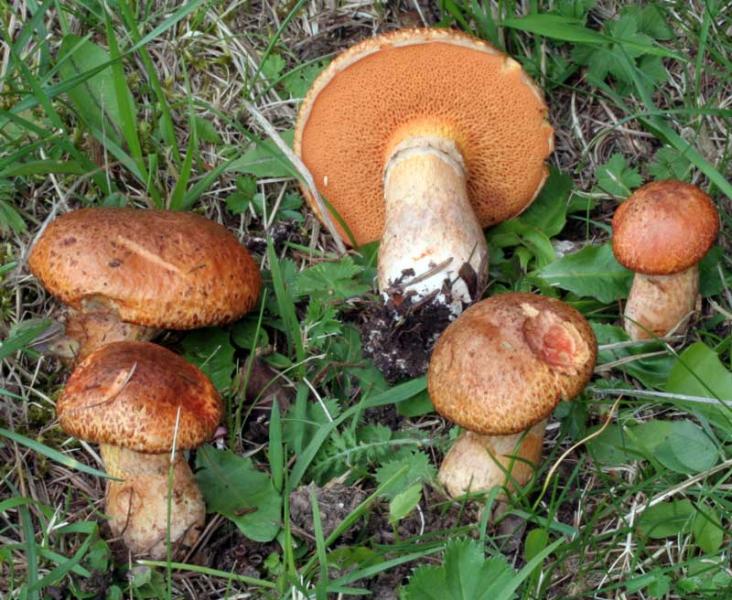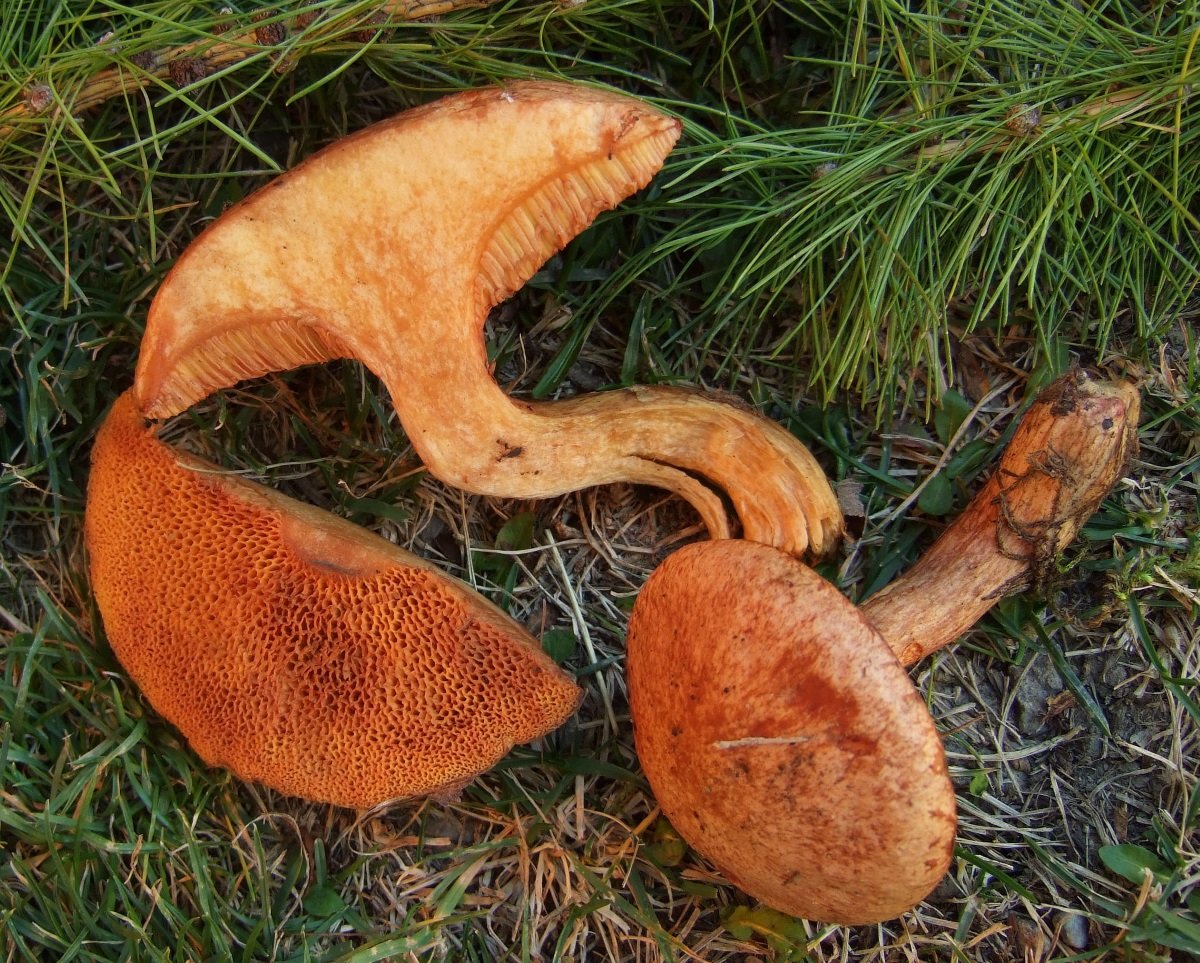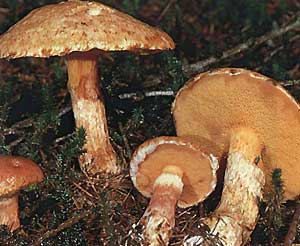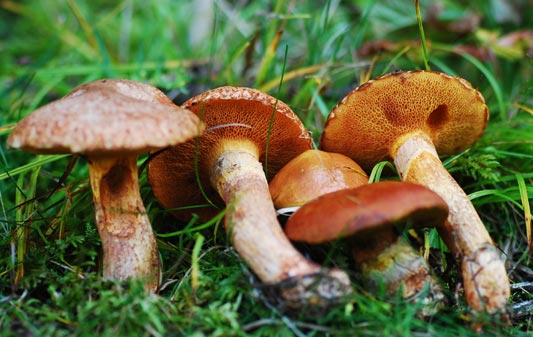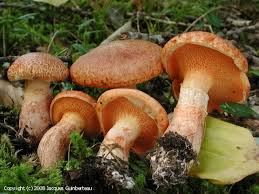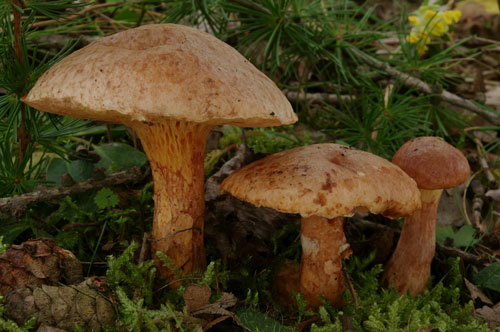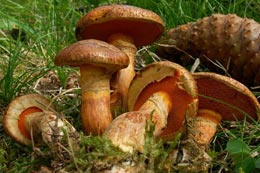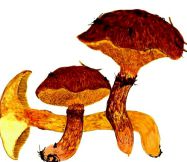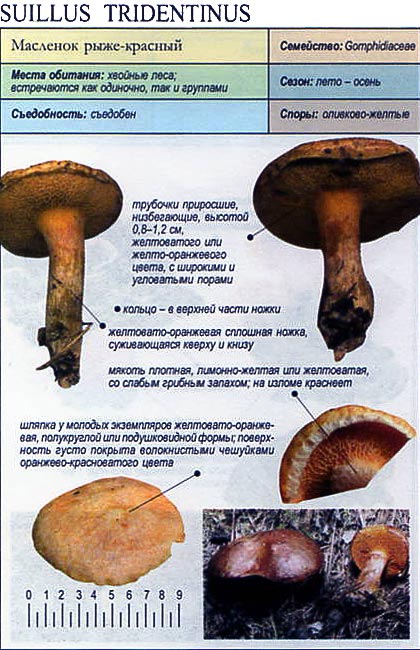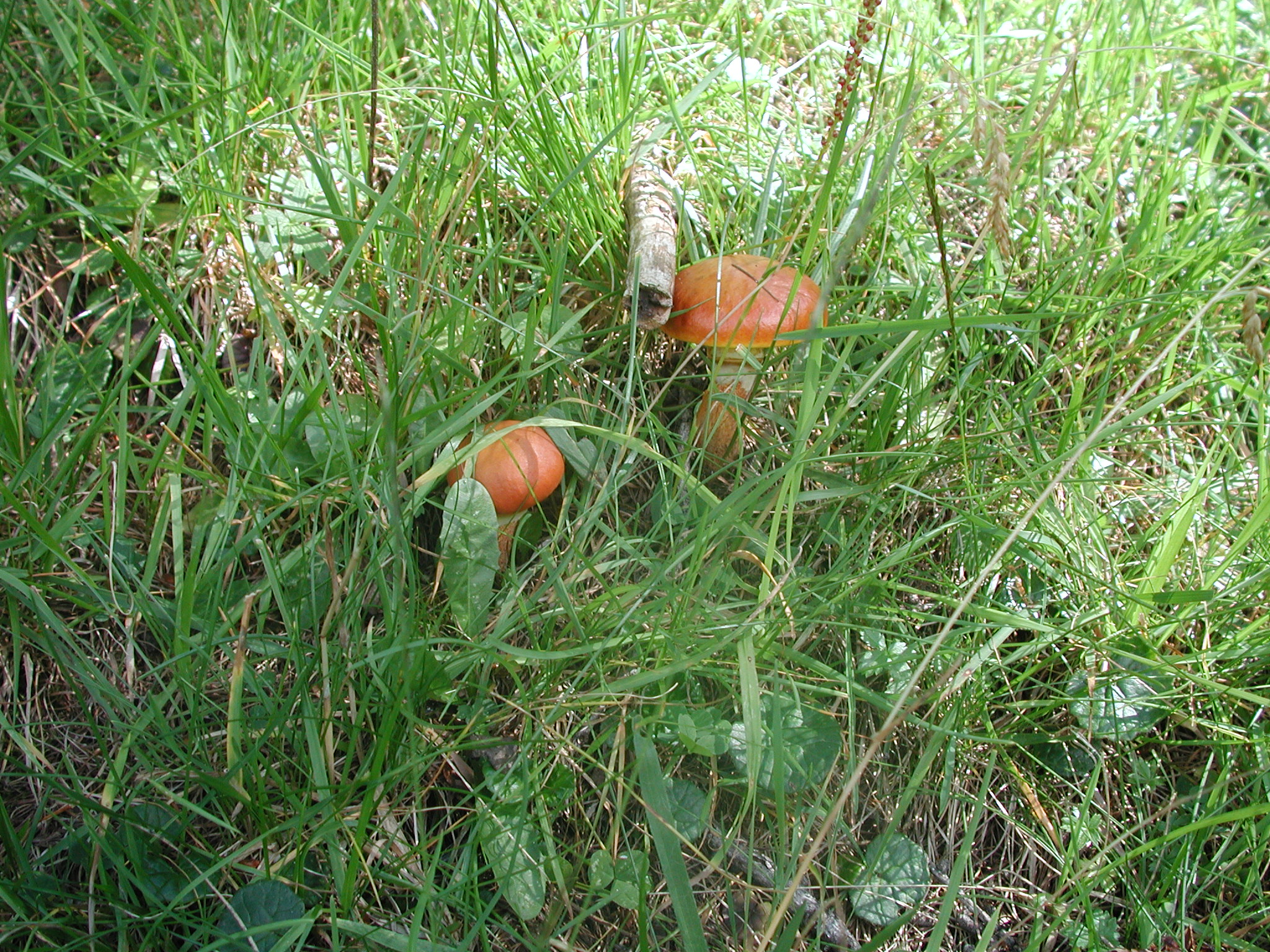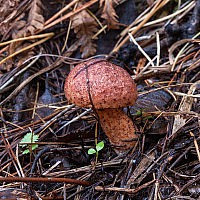Definitioner
- Basidia (Basidia)
-
Lat. Basidia. A specialized structure of sexual reproduction in fungi, inherent only in Basidiomycetes. Basidia are terminal (end) elements of hyphae of various shapes and sizes, on which spores develop exogenously (outside).
Basidia are diverse in structure and method of attachment to hyphae.
According to the position relative to the axis of the hypha, to which they are attached, three types of basidia are distinguished:
Apical basidia are formed from the terminal cell of the hypha and are located parallel to its axis.
Pleurobasidia are formed from lateral processes and are located perpendicular to the axis of the hypha, which continues to grow and can form new processes with basidia.
Subasidia are formed from a lateral process, turned perpendicular to the axis of the hypha, which, after the formation of one basidium, stops its growth.
Based on morphology:
Holobasidia - unicellular basidia, not divided by septa (see Fig. A, D.).
Phragmobasidia are divided by transverse or vertical septa, usually into four cells (see Fig. B, C).
By type of development:
Heterobasidia consists of two parts - hypobasidia and epibasidia developing from it, with or without partitions (see Fig. C, B) (see Fig. D).
Homobasidia is not divided into hypo- and epibasidia and in all cases is considered holobasidia (Fig. A).
Basidia is the place of karyogamy, meiosis and the formation of basidiospores. Homobasidia, as a rule, is not functionally divided, and meiosis follows karyogamy in it. However, basidia can be divided into probasidia - the site of karyogamy and metabasidia - the site of meiosis. Probasidium is often a dormant spore, for example in rust fungi. In such cases, probazidia grows with metabasidia, in which meiosis occurs and on which basidiospores are formed (see Fig. E).

See Karyogamy, Meiosis, Gifa.
- Pileipellis
-
Lat. Pileipellis, skin - differentiated surface layer of the cap of agaricoid basidiomycetes. The structure of the skin in most cases differs from the inner flesh of the cap and may have a different structure. The structural features of pileipellis are often used as diagnostic features in descriptions of fungi species.
According to their structure, they are divided into four main types: cutis, trichoderma, hymeniderma and epithelium.
See Agaricoid fungi, Basidiomycete, Cutis, Trichoderma, Gimeniderm, Epithelium.
Oiler red-red: photo and description
| Name: | Oiler red-red |
| Latin name: | Suillus tridentinus |
| Type of: | Edible |
| Synonyms: | Oiler Trident |
| Systematics: |
|
The reddish-red oil can is an edible representative of the mushroom kingdom. It is ideal for frying, salting and pickling. But in order not to make a mistake when collecting and not to collect poisonous specimens, you must be able to recognize the species by appearance, know the place and time of growth, and also carefully look at the photo.
What does a reddish-red oil can look like?
The reddish-red butter dish is a rare edible specimen. During the mushroom picking, it is impossible to pass by this handsome man, since he has a bright reddish-red cap and a tubular layer resembling a saffron milk cap in color. The mucous layer that appears during rainy weather will help to distinguish between the two types.
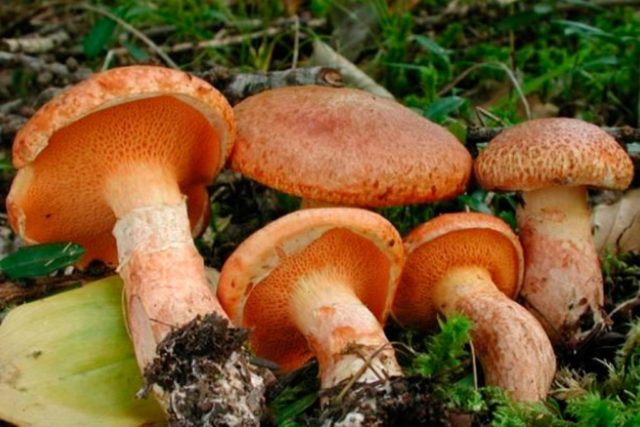
Description of the hat
The diameter of the cap of the reddish-red oiler is 10-150 mm. At a young age, it has a hemispherical shape; with age, it straightens and becomes flat. The rough surface is covered with a large number of bright orange scales. After rain, a mucous membrane appears on the surface.
The color of the cap can be varied: orange-yellow, pale orange, red-brown.With age, the color of the cap darkens. You can often see snow-white flakes at the edges of the cap, left over from the white blanket, which covers the tubular layer in young specimens.
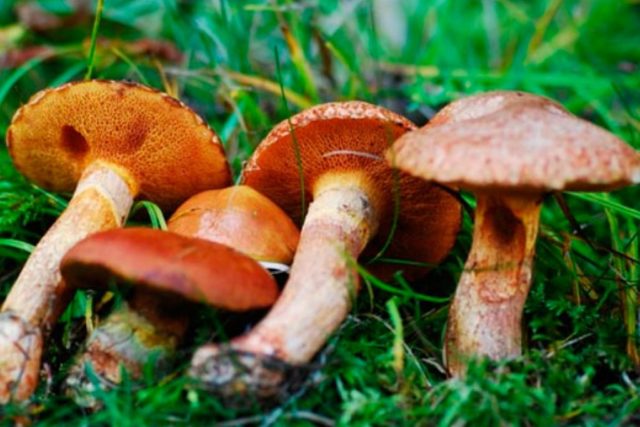
Light yellow pulp is dense, fleshy, with mechanical damage it turns reddish. The tubular layer is formed by angular, orange-yellow, irregularly shaped tubes.
Leg description
Cylindrical stem in reddish-red mushrooms up to 10 cm long, 35 mm thick. The upper part is crowned with a filmy ring, which was formed from a snow-white bedspread.
Above the ring, the flesh is lemon-colored, the lower part is lemon-orange. The stem is fibrous, fleshy with a weak mushroom aroma.
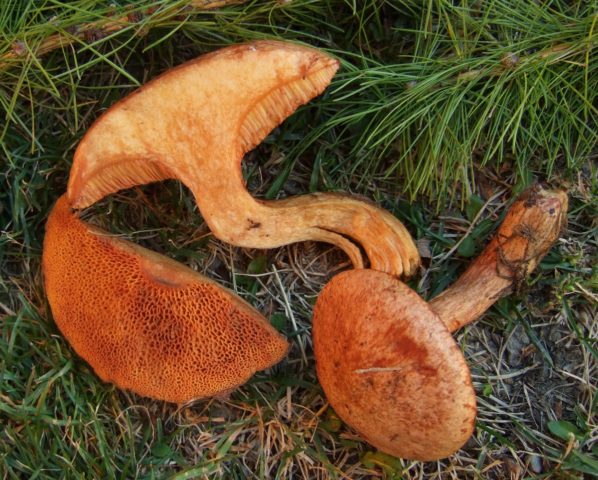
Where and how does the reddish-red oil can grow
Red-red mushrooms are a rare species, therefore, to collect it, you need to know its time and place of growth. This species is very popular in Europe, it grows in the Alps and in Finland. In Russia, reddish-red boletus is found in Western Siberia, Altai, Krasnoyarsk Territory and Irkutsk Region. Red-red ribs prefer coniferous forests with lime-rich soil. Fruiting occurs from July to late September.
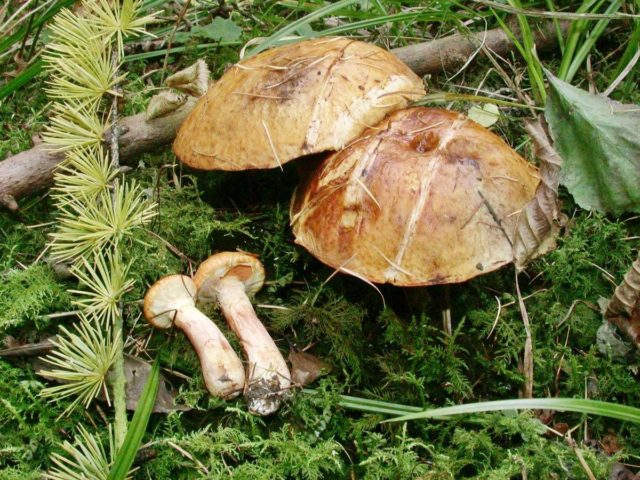
Reddish-red oiler doubles and their differences
The reddish-red specimen has edible counterparts. These include:
- Goat. Outwardly, the appearance is very similar to the flywheel. But you can recognize it by its slimy brown hat. The leg and cap are of the same color, the flesh is lemon-colored; during mechanical damage it becomes reddish-brown. Goats prefer to grow in coniferous forests, in regions with a temperate climate. Fruiting occurs from July to September.
- Cedar oil can. An edible specimen with a dark brown cap. In young mushrooms, it has a hemispherical shape, with age it becomes fibrous and cushion-shaped. The yellow-brown leg grows up to 10 cm, the flesh is fleshy, fibrous, with a light mushroom aroma. The species grows in young cedar and coniferous forests. It can be found in the Far East and Siberia. Fruiting occurs at the time of flowering pine from July to late September.
- Early oiler. Belongs to the 2nd category of edibility. Early oiler is common in pine forests, grows from June to September in the Caucasus. It often grows in large families, so when you find a mushroom clearing, you can quickly collect a whole basket.
How red-red boletus is prepared
The reddish-red mushroom belongs to the 2nd group of edibility. It reveals its taste when fried, stewed and canned. Before cooking, the mushrooms are cleaned and boiled in salted water. You can also make blanks for the winter: freeze and dry. Dried boletus is stored in paper or rag bags in a dark, dry place. The shelf life is about 1 year.
Conclusion
The reddish-red oiler is a delicious mushroom that is ideal for many dishes. But in order not to make a mistake during mushroom hunting and not to collect poisonous specimens, you need to know the varietal characteristics, view photos and study the time and place of growth.
Swamp butter dish - Suillus flav> Written by Nikolay Budnik and Elena Meck.
We used to think that this is a kind of Goat. For these small and unattractive mushrooms, you don't even want to bend over, and only hats stick out in the moss. It turned out that this was not a Goat, but a Swamp butterdish.
The Swamp Butter has a slimy ring on its leg. The cap of the mushroom is yellowish-greenish with a “pimple” on the crown; it is covered with radial fibers of a darker color. And the Goat's hat is more reddish-ocher and without a “pimple”, sometimes with dark dots. When you see the leg and the remnants of the ring on it, you can immediately determine whether the Oiler is in our hands or the Goat.
We read with interest that in Slovakia the Swamp Butter is listed in the Red Book. The fine for each hat torn off is 50 euros. You can imagine how much we would have to pay for the Swamp boletus, shown in our photos, if we lived in Slovakia, and not on Ulom Zheleznaya.
We sometimes take the Swamp Butter. He rarely comes across.Yes, and in the swamp in early autumn, when this mushroom grows, we do not often visit. It is during this period that other best mushrooms grow.

1. We met the swamp butter dish on Ulom Zheleznaya rarely.

2. The name shows that it grows in a swamp.

3. And at this time we rarely go to the swamps.

4. Swamp butter dish is a small and puny fungus.

5. But it tastes good.

6. We collect it sometimes, when we come across it, and when there are few other mushrooms.

7. The marsh oiler grows at the same time as other boletus, or a little later.

8. It can be found in a fairly dry swamp.

nine. . on moss bumps.

10. Here we see blueberry bushes and lingonberry next to the marsh butterdish.

11. The mushroom is small in size.

12. And he is all thin and frail.

13. Only the cap usually sticks out above the surface of the hummock.

14. The leg is long enough, but it is all hidden in the moss.

15. Here is the average size of a swamp oil can.

16. The cap of the mushroom is yellowish-greenish in color.

17. It is covered with darker radial fibers.

18. There is always a small tubercle in the middle of the cap.

19. The hat is rarely even and round.

20. In most cases, its edges are wavy, and the surface is uneven.

21. The cap is small and thin fleshy.

22. The tubular layer is brightly colored.

23. Usually these are different shades of yellow.

24. The pores are very large and angular.

25. This is how they join the leg.

26. Let's take a closer look at this.

27. The stem of the mushroom is rather long and thin.

28. The ring is always visible on it.

29. These are the remains of a film bedspread.

30. This is how the leg joins the hat.

31.. and like this - to the ground.

32. Inside, the leg is solid, dense.

33. The flesh on the cut is slightly watery, may darken slightly.

34. This is this rare and small mushroom.
And now, after taking a photo of the Swamp Butter, you can watch a small video sketch about this mushroom.
Butterlets (Suillus). Description, distribution and types of oil
It's already the middle of summer, which means that the "mushrooming" begins! And to remind you of some useful information about mushrooms, today we will talk with you about boletus. How can we live without them, in our native forests? Indeed, in terms of popularity and taste, boletus are not particularly inferior to their "white" fellow citizens, who, moreover, are their relatives. So…
Butter dish (Latin Suillus) is a genus of tubular mushrooms of the Boletovye family (Latin Boletaceae).
Category: edible mushrooms.
The oiler got its name from the cap that is oily (slippery) to the touch.
The main difference between the oiler and other painful mushrooms is the cap, which is slippery to the touch, from which the skin can be easily removed. In addition, under the cap there may be a light coverlet, which in adult mushrooms leaves only a trace of its early presence at the top of the stem.
Description oiler
The oiler has a smooth cap, from convex to flat in shape, the surface of which is usually sticky or slimy, with an easily peeled skin. There may be a private cover under the hat.
The hymenophore (the porous part of the flesh of the cap) is easily separated from the cap, seemingly yellow or white, adherent or descending along the stem.
The stem is solid, smooth or grainy, sometimes with a ring (remnants of a private bedspread).
The flesh is whitish or yellowish; on the cut it can change color, from blue to red.
Spore powder of various shades of yellow.
Spreading Oiler
All types of oil are mycorrhizal formers with conifers, mainly with double or five-coniferous pines and larch trees.
Most of the boletus species are found in the temperate zone of the Northern Hemisphere, although native and introduced species are found in many regions of the world, and even on continents such as Africa and Australia.
Useful properties of the oiler
The butter dish is rich in vitamins B2, B6. These mushrooms also contain fiber, carbohydrates, amino acids, fat-like substances - fatty acids, essential oils, and lecithin, which prevents the deposition of cholesterol. In addition, boletus relieves acute headache, because they have a special resinous substance.When using the oil can, the effect of accelerated excretion of uric acid is also noticed, which helps in the fight against gout.
The calorie content of butter is 19.2 kcal.
Nutritional value of butter: proteins - 0.9 g, fats - 0.4 g, carbohydrates - 3.2 g.
Caution, boletus!
In addition to useful properties, boletus has some negative effects on the body. So, the fiber in the oiler is saturated with chitin, which interferes with the good digestibility of these mushrooms. Therefore, it is not recommended to use a large amount of oil can. Experts say that chitin is not only not digested in the human gastrointestinal tract, but also makes it difficult for digestive juices and digestible substances to access. The digestibility of mushrooms will deteriorate, in particular, also by the fact that mushroom proteins mainly belong to difficultly soluble substances.
Doctors consider mushrooms to be difficult to digest.
What to do with boletus?
Butterlets can be prepared in the following ways:
- to extinguish; - cook; - fry; - pickle; - salt; - dry.
The most delicious are fried and pickled butter.
Types of butter
The genus Oiler unites about 50 species of mushrooms.
In view of the peculiarities of morphology, some taxonomists classify the genus of boletus (Suillus) to the family of moss (lat.Gomphidiaceae), or altogether separate it into a separate family of Suillaceae.
Below, for convenience, I have divided the types of butter into 3 categories, depending on the edibility.
Edible species:
Oiler ordinary, oily can late, oily can yellow, oily can, autumn oily (Suillus luteus).
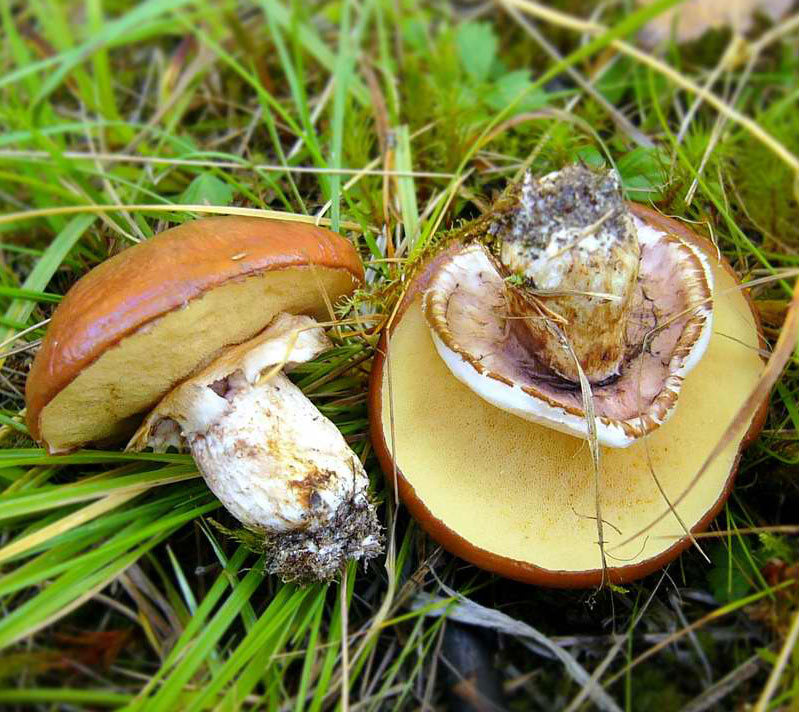
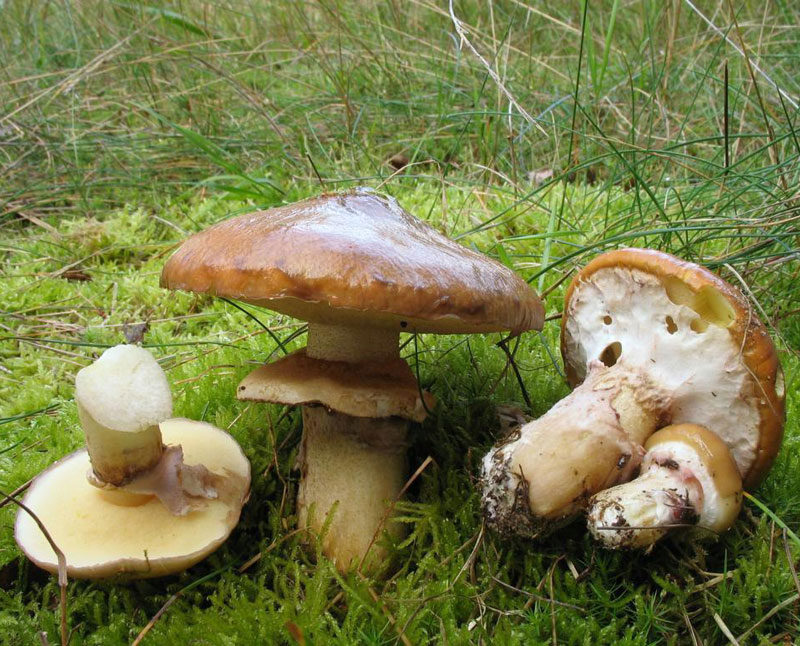
Bellini butter dish (Suillus bellinii).
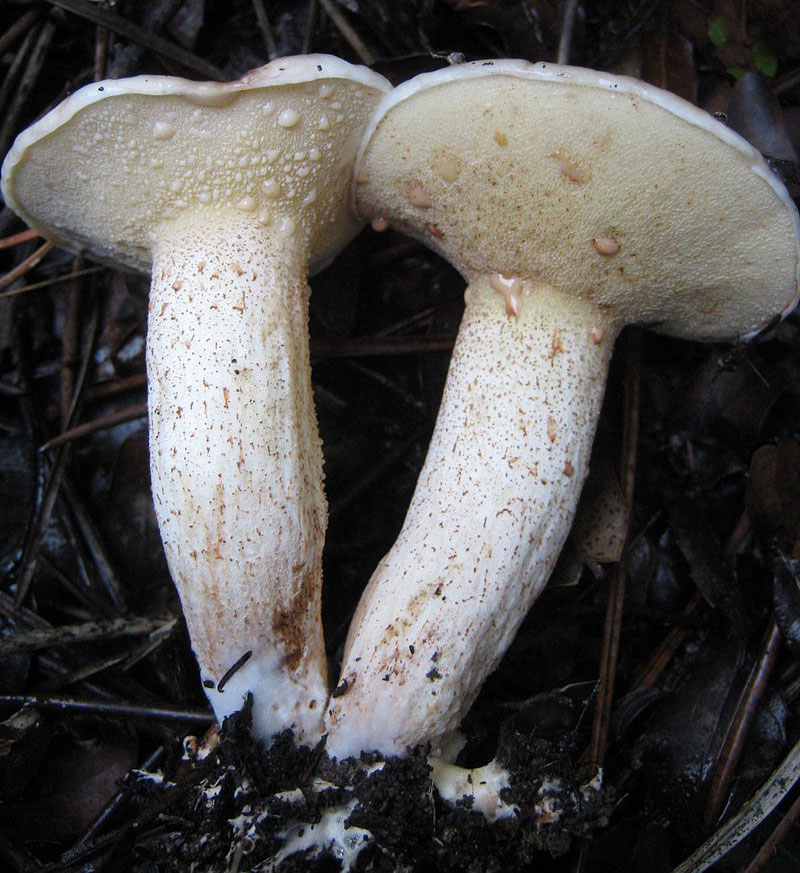

Belted butter dish (Suillus clintonianus).
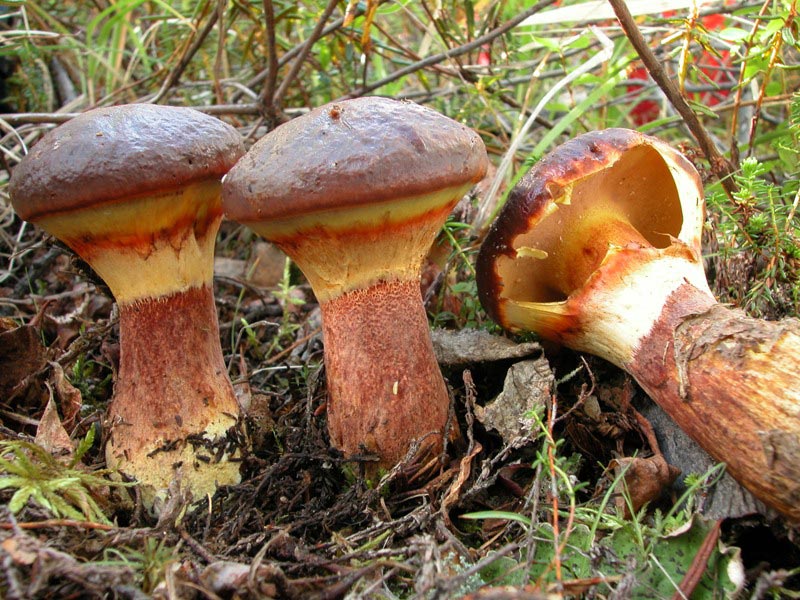
Butter dish is marsh, butter dish yellowish (Suillus flavidus).

Granular butter dish, summer butter dish (Suillus granulatus).
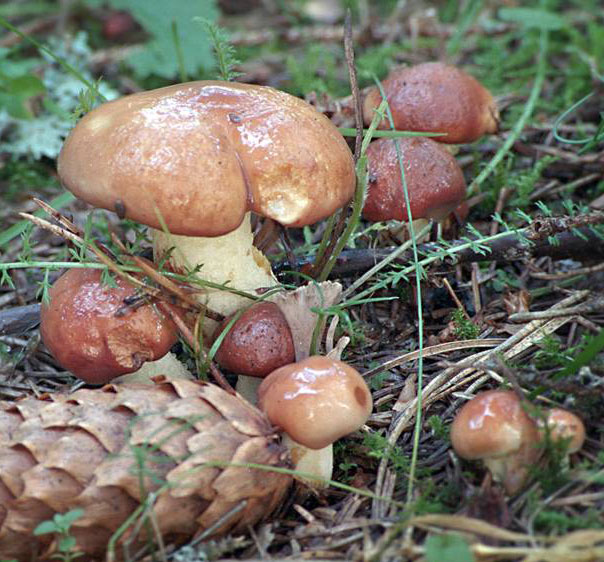

Butter dish is white, butter dish is pale, butter dish is soft (Suillus placidus).

Ruby butter dish (Suillus rubinus).
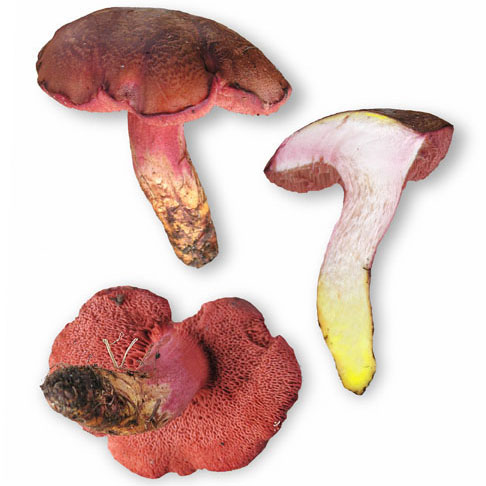
Red-red butter dish (Suillus tridentinus).
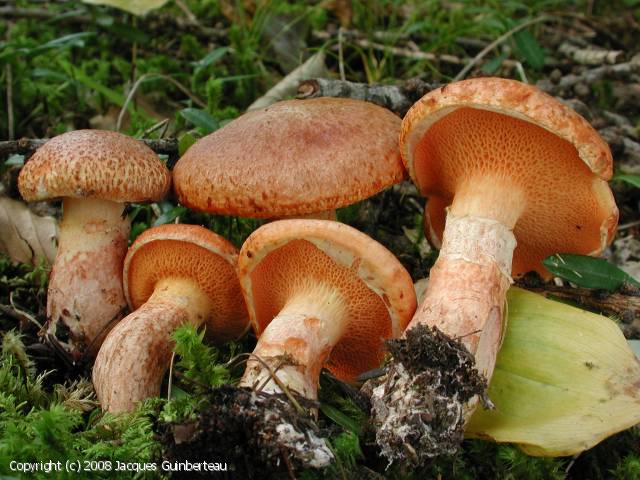
Butter dish yellow-brown, swamp butter dish (Suillus variegatus).
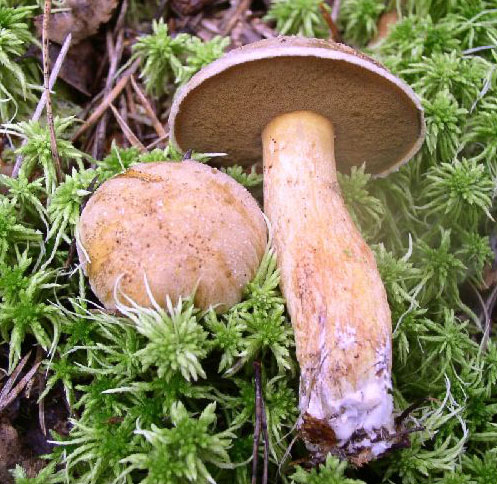
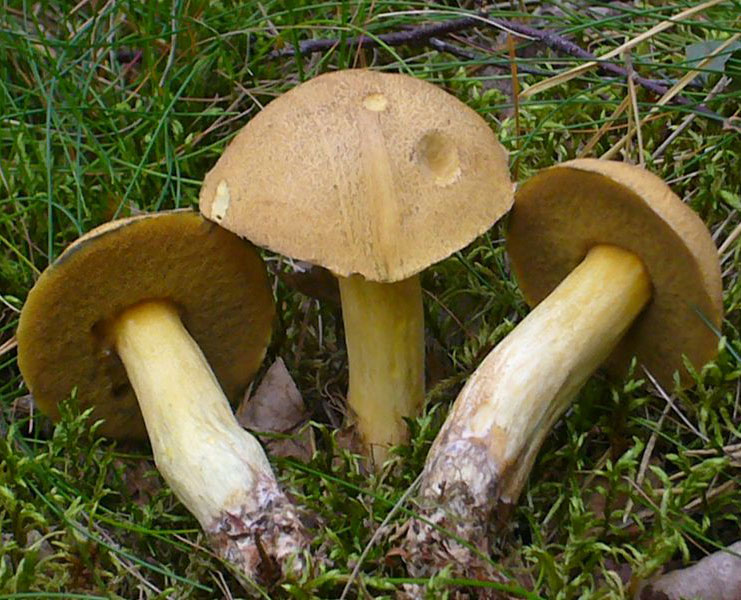
Conditionally edible species
Larch Butter (Suillus grevillei (Suillus elegans)).
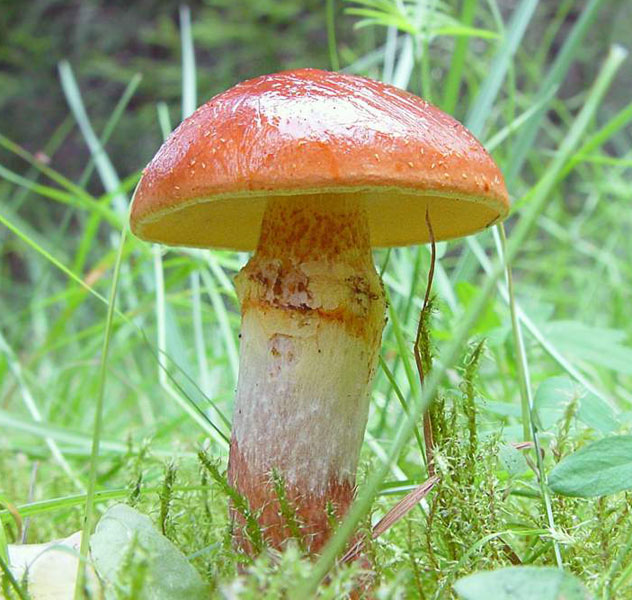
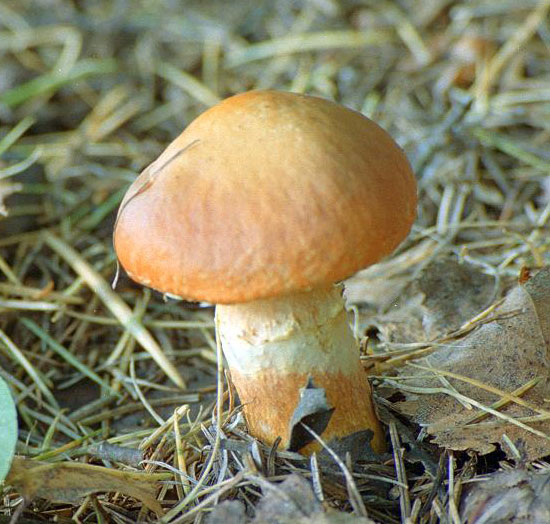
Greyish oiler, blue larch oiler (Suillus aeruginascens).
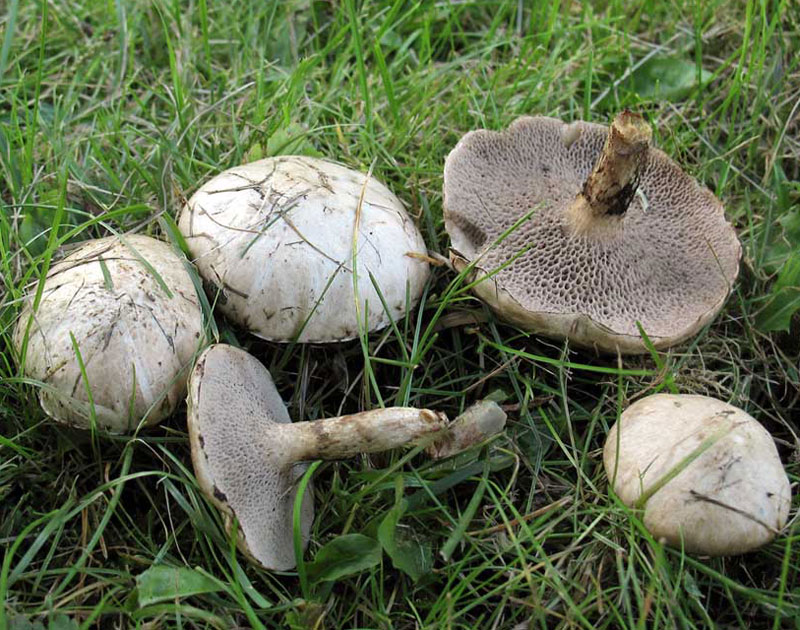
Goat, sieve (Suillus bovinus).
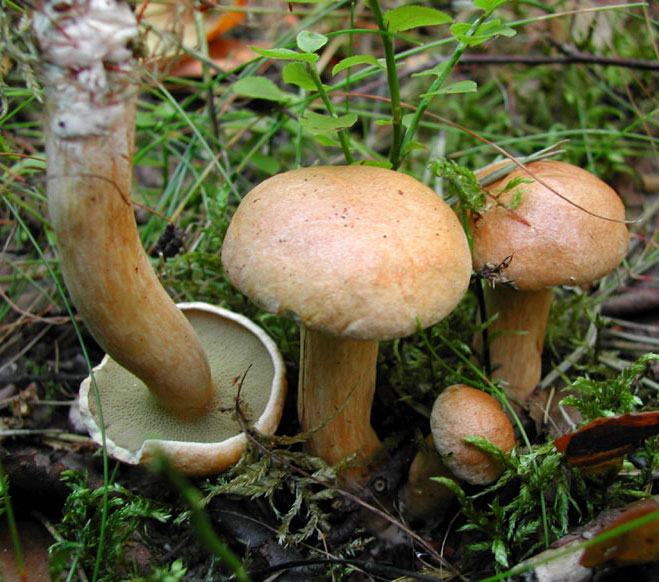
Yellowish butter dish (Suillus salmonicolor).

Inedible species
Peppercorn, pepper mushroom (Suillus piperatus).

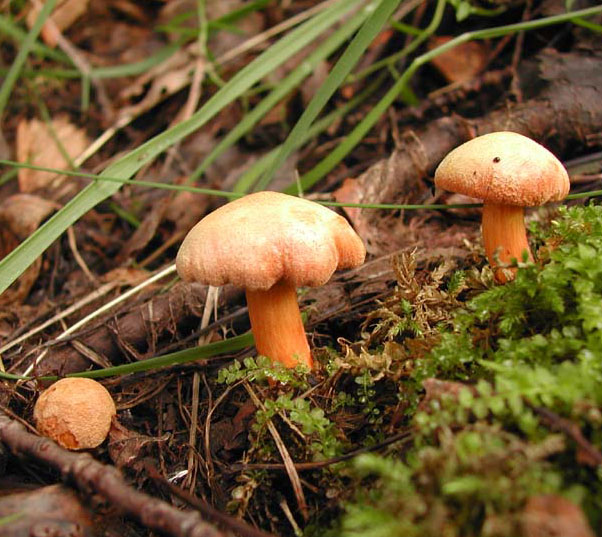
Siberian butter dish (Suillus sibiricus).

Notable butter dish (Suillus spectabilis).
Oiler red-red
Oiler reddish-red - Latin Suillus tridentinus
In a different way, this mushroom is called the Trident Butter or the Trentine Butter.
Description
Mushroom cap
The diameter of the Tridentan Oiler's hats is 50-150 mm. At a young age, they have the shape of a hemisphere or pads, later they become more open and flat.
The hat is covered with a rough skin dotted with many fibrous reddish-orange scales that run radially and give the hat a cracked appearance. In rainy weather, it becomes covered with mucus. The colors of the "headwear" are orange - yellow, pale orange, red - orange or red - brown. The older the Trentian Butter, the darker the color of the hat. Occasionally, flaky pieces of white bedspreads remain on the edges of the hats.
The hats are filled with a tight, fleshy pulp of a yellowish, lemon-yellow, just yellow or yellow-brown hue. If damaged, it turns reddish.
The hat bottom consists of an accreted tubular layer of yellowish or orange-yellow tubes with large pores and torn edges, running down the legs. The pores are irregular and angular.
The reddish-red oiler reproduces by elongated yellowish-olive spores that form in an olive-yellow or olive-brownish spore powder.
Stipe
Legs of reddish-red boletus usually taper upwards, occasionally downwards, and reach 10-35 mm in thickness and 40-100 mm in length. The leg has the shape of a cylinder and a filmy ring left over from the bedspread.
Above the ring, it turns yellowish and is covered with a fine mesh, below the ring, the leg is yellow-orange. Closer to the base, a longitudinal pattern of a darker shade is often formed on the legs.The flesh consists of soft fibers and is colored in the same way as the hat, but it is somewhat darker.
Oiler reddish-red - Latin Suillus tridentinus
Places of growth and fruiting
The reddish-red oiler prefers soils rich in limestone, and chooses soil near the rhizomes of larch for growth and fruiting. The fungus is quite rare, and in some regions it is listed in the regional Red Data Books as an endangered species.
Mushroom pickers collect it in the plain and mountainous Altai, West Siberian and Alpine forests, in European countries.
Fruiting of the mushroom is single or small-group, and depending on the area and climate, it occurs in July - end of October or the last days of May - the first week of November.
Edibility
The pulp of the Tridentine butterdish is weak, but it smells like mushrooms and has a very pleasant taste with sour notes. It is considered edible and belongs to the 2nd category of edibility as a mushroom with high nutritional qualities.
Trentino butter can be eaten stewed and fried, added to soups, sauces and salads, pickled, salted and dried for the winter.
Larch butter dish
Larch butter dish - Latin suillus grevillei
In another way, it is called the Elegant Butter.
Description
Mushroom cap
Larch boletus has fleshy caps that grow up to 30-150 mm in diameter. Young hats have the shape of a cone or hemisphere with a folded edge, adults become almost flat, in some specimens the edges are bent upward.
"Hats" are covered with a smooth, sticky skin, shimmering and easily detached from the hats. It can be golden yellow, bright yellow, brownish, lemon yellow, yellowish red and even brownish yellow-gray.
The caps are filled with dense, but soft and juicy yellowish pulp, which turns brown under the skin, and does not change color if damaged if the mushroom is young. After cutting, the pulp of mature specimens sometimes acquires a pinkish or reddish-brown hue, turning into a brown tone.
The bottom of the hat has a tubular structure of short tubes growing to the legs or slightly descending along them. At first, they are covered with a yellowish veil, but as it grows, it breaks, leaving behind a ring on the leg. The tubular mass is colored in a yellowish or yellow-olive tone, if you press on it, it becomes brown. From tiny pores, tiny drops of a whitish hue stand out, forming brownish spots when dried.
The elegant buttercup reproduces by smooth, elongated, pale yellow spores contained in ocher olive spore powder.
Stipe
The larch oiler builds up a cylindrical or clavate, slightly curved hard leg, reaching 20 mm in thickness and 40-80 mm (sometimes 120 mm) in height. The leg has a granular - mesh structure and a yellowish membranous ring that remains after the veil disappears.
The upper part of the legs is colored yellow, below the ring - in a brownish-red tint. Inside, it is completely filled with lemon-yellow pulp.
Larch butter dish - Latin suillus grevillei
Growing places
Larch boletus prefer conifers with pines, spruces and larch trees, but they grow under larch trees, especially under young ones. They are collected in the Far Eastern, Ural, Siberian, North American and European forests with acidic fertile soil. They are also found in the European part of Russia.
Fruiting occurs in scanty groups and singly, begins in mid-June and ends in early - late October.
Edibility
The pleasant aftertaste and light fruity aroma make Buttercup an elegant and desirable ingredient in the dishes of every gourmet who loves mushrooms. It belongs to the 2nd category of edibility and is used in pickled, salted, fried and stewed form, in soups, sauces and salads. By the way, scientists believe that eating this mushroom helps relieve headaches.
The main thing is to have time to harvest young mushrooms, since mature specimens often turn out to be wormy
It is also important to remove the skin from the caps: if it is dry, hold the mushrooms in boiling water for two minutes


